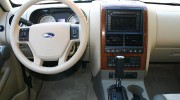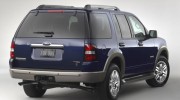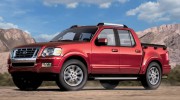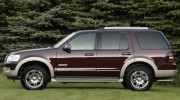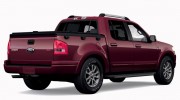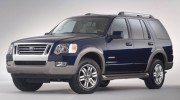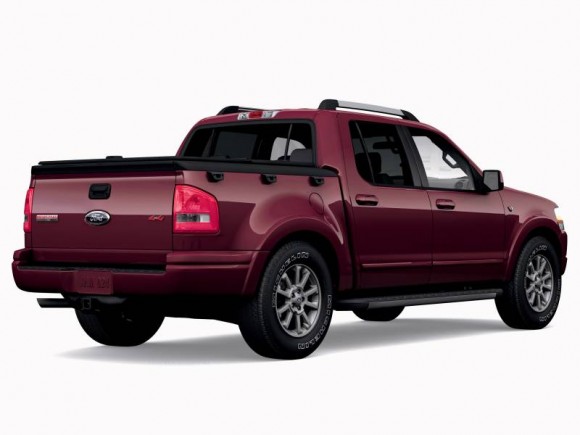
The best-selling sport-utility vehicle in America gets a complete makeover for 2006. The Explorer comes in RWD and 4WD form. Engine choices now include the Mustang V8. The five-door is standard, and the Sport Trac pickup came in 2007.
Pros :
– Roomy interior.
– Car-like ride quality.
– Classy styling touches.
– Tons of trim choices.
– Optional third row seating.
Cons :
– Poor fuel economy.
– Not many changes for the new model.
– No more three-door Sport.
– Very heavy for a mid-size SUV.
– Reputation tarnished by rollover fiasco of earlier models.
Review :
How do you improve upon a vehicle that created its segment and has continued to be the sales leader for 15 straight years? For the 2006 Ford Explorer, the answer is more power, improved fuel economy, low emissions, new advanced safety technologies, class-leading interior quietness, improved ride comfort and bolder styling. Ford Explorer has been the world’s best-selling SUV for 15 consecutive years with sales totaling nearly 5.5 million because it adheres to a simple formula: put people first. Since its introduction in 1990, Explorer has defined the SUV segment by offering the capability of an SUV for towing and off-roading, along with innovations in package, comfort and refinement.
SUVs have been the fastest-growing vehicle type over the past 15 years, but market dynamics are clearly changing. For customers who need a traditional SUV, the 2006 Explorer’s combination of features and capabilities is unmatched. The 2006 Ford Explorer continues Explorer’s legacy of offering genuine SUV capability with innovative refinement, packaging and driving dynamics.
The 2006 Explorer’s new optional three-valve 4.6L SOHC V8 that shares the same variable cam timing and three-valve cylinder heads used on the highly lauded Mustang GT and the 5.4L Ford F-150 engine. In the Explorer, the new 4.6L delivers 292 hp and 300 lb-ft of torque. The V8 is fitted to the first six-speed automatic in the segment, with a wide 6.04:1 gear ratio, enabling the engine to spend more time in its optimum powerband – either at peak power for acceleration, or at peak efficiency for more fuel economy.
As a result, V8 4×4 models are expected to deliver up to 10 percent improvement in fuel economy, in addition to an increase of 53 more horsepower. And the new V8 delivers low emissions, as well. It is expected to qualify for the stringent Tier II, Bin 5 federal standards, which is compliant with California’s Low Emissions Vehicle II (LEV II) standards.
The Ford Explorer’s standard 4.0L SOHC V6 engine received significant improvements for the 2006 model year as well. Idle quality was improved by 50 percent, thanks to a new camshaft and spark plugs. New engine calibrations and improved emission controls cut smog-forming emissions by 74 percent compared to the previous model. These improvements are expected to allow the 2006 Explorer V6 to meet federal Tier II Bin 4 emissions requirements to achieve ULEV II status – the same federal tailpipe emissions standards as the Ford Escape Hybrid, the world’s cleanest SUV.
The 2006 Ford Explorer leads its class with 10 standard advanced safety technologies. Seven of these 10 standard features are new to the mid-size SUV class, including four new adaptive technologies specifically designed for Ford’s stringent internal safety targets. The new Explorer provides the most active and passive safety features in its class.
In fact, the new Explorer meets all known federal frontal- and side-impact crash requirements through 2010. Explorer already achieves one of the best impact-protection ratings among mid-sized SUVs, according to the National Highway Traffic Safety Administration’s 2005 model year New Car Assessment Program (NCAP) data. The new 2006 model is expected to improve on that rating.
The 2006 Explorer features improvements and new features to help further protect occupants during a rollover or side-impact. As with the previous model, the 2006 Explorer offers available Safety Canopy side air curtains that deploy in certain side-impact collisions or if an impending rollover is detected to help protect front- and second-row outboard occupants. The air curtains feature “roll-fold” technology. If an occupant is improperly seated and resting his head against a window, the Safety Canopy is designed to slide between the glass and occupant as it inflates. A new front “sail panel” of fabric attached to the A-pillar also helps position the Safety Canopy. Also new for 2006 are standard side-impact air bags for the driver and front passenger. Mounted in the outboard side of each front seat, these air bags further enhance protection for the an occupant’s chest in the event of a side collision.
The new Explorer interior benefits from a concerted effort by Ford engineers to decrease unwanted noise in the cabin. In fact, the Explorer team focused on every aspect of the vehicle, from the exterior, interior, chassis and powertrain to quell noise, vibration and harshness. Significantly, the Explorer is not only quieter measured in the first row, but the third row is quieter than the second row of most competitors at highway speeds. In fact, the Explorer’s third row is just as quiet as some competitors’ front row. This is a key to passing Ford’s speed intelligibility tests, which enable occupants in the first row to effortlessly hold a conversation with passengers in the second and third rows at highway speeds.
In the Sport Trac, the 4 ½-foot cargo box is constructed of corrosion-proof sheet molded composite (SMC) with a molded-in black inner liner that resists scratches and is dent-proof. The box is notched, allowing customers to place two 2×4 boards across the span to provide tiered storage of materials – including the ubiquitous 4×8 sheets of plywood. The outer SMC shell is painted body color and accented with tie-down anchors, emphasizing the Sport Trac’s functional design. Inside the box are three integrated cargo bins designed to maximize cargo-carrying ability and contribute to Sport Trac’s versatility. The bins are recessed into the bed floor, with two six-pack-sized bins in the right and left rear of the box and one large bin that runs the length of the box headboard. The bins are equipped with weather-resistant lids and removable drain plugs for storing wet gear or ice.
The all-new interior features the use of advanced materials that dampen vibrations and lessen noise. New insulation materials have been used along the headliner, door panels and floor of the passenger compartment to help provide class-leading interior quietness. Also improving interior noise levels is an all-new frame. Thanks to increases in section height and width, it is 63 percent more resistant to bending and 55 percent more resistant to twisting. The Explorer adopts the F-150’s tube-through-tube frame design, where the cross members pass through the section of the frame-rails, creating an inherently stronger joint. These joints are then completely welded around the perimeter for a fully boxed seam. The stiffer frame provides a smoother ride with better road feel, crisper handling and improved steering response because it allowed Ford engineers to improve the vehicle systems the stronger frame supports – including the front and rear suspensions, and the braking and steering systems.
Explorer’s improved independent rear suspension now features trailing arms and is more robust to accommodate the vehicle’s increased towing and payload capability, yet is slightly lighter than the previous short- and long-arm assembly. As before, the rear half shafts pass through frame portholes, lowering the independent rear suspension subframe for better third-row packaging and a lower center of gravity. The front suspension also is new, retaining basic geometry with upper and lower control arms and a sway bar. It too features stronger components, yet is slightly lighter weight overall. Both front and rear suspensions now feature monotube shocks – replacing twin-tube shocks. The monotube shocks are tuned to take advantage of the stiffer frame, delivering even less impact harshness for improved ride comfort while still delivering excellent primary ride control. The Sport Trac’s rear coil-over springs, monotube shocks, and a stabilizer bar have slightly stiffer rates than those of the 2006 Explorer, to adjust for the longer wheelbase and change in weight distribution.
As before, the four-wheel disc brake system features standard anti-lock brakes, electronic brake distribution and electronic brake assist. For 2006, Explorer’s brake system has been redesigned for improved heat dissipation and durability. These changes helped increase the vehicle’s maximum capacities. With a 1,520-pound payload and 7,300-pound tow rating, the 2006 model is the most capable Explorer ever.
The 2006 Explorer has an all-new interior with improved accommodations for all occupants. New front seats with available 10-way power on the driver’s seat provide more comfort and ride on extended tracks that allow a full inch more travel. The second row is available in three configurations; a 60-40 (no reclining) split, a reclining 60-40 split that allows access to the third row, and bucket seats separated by a center console. New, larger head restraints provide enhanced safety and articulate for improved rear visibility when the seat is unoccupied.
The available third-row seats’ bench height was raised 1.75 inches, providing better visibility for children while still affording comfortable headroom for taller occupants. Both the second and third rows of seats fold completely flat, when equipped with the second-row bench seat. Where previous seven-passenger Explorers had a slight incline of the load floor – approximately 10 degrees from horizontal – the redesigned seats allow a virtually flat floor, only two degrees from horizontal. The new fold-flat floor design also increases usable cargo volume in the flattest position. The 2006 Explorer is available with sophisticated details such as Preferred Suede seat inserts and contrasting stitching paired with strong, vertical lines and wood trim. In addition, the new center stack houses Explorer’s first available DVD navigation system – the first system in its segment to include spoken upcoming street names as part of its text-to-speech programming. Also a first for Explorer is the console-mounted transmission shifter.
Fitting the Explorer’s increased capability, the new model features a new, bolder exterior design. Though the 2006 Explorer features the same footprint, solid proportions and planted stance as the outgoing model, the new Explorer has a much larger presence, most noticeably in the all-new front end. Everything is new from the base of the windshield forward. The new grilles, with three distinct styles wrapping the larger seven-inch Ford blue oval, make the strongest statement.
Like the front of the 2006 Explorer, the rear infuses Explorer’s classic look with a bold new attitude. The 2006 model also offers available 18-inch chrome wheels wrapped in P235/65R-18 all-season tires for a more rugged appearance. These changes visually communicate power, capability, and durability, reinforcing Explorer’s traditional, authentic SUV roots.
The 2006 Explorer will be available in four trim levels: XLS, XLT, Eddie Bauer and Limited. XLS is the value entry, for younger families that want a medium-size SUV, not a small SUV or a crossover. The XLT is the core offering, totaling 50 percent of Explorer models. These customers tend to be older than XLS buyers and need to carry a family. The Eddie Bauer model has become the quintessential Explorer model, offering the best of both worlds: It offers capability and a bold style, paired with luxury amenities. The standard Eddie Bauer model will offer 17-inch wheels, leather-trimmed seats, wood trim and unique chromed grille. The available luxury package adds the choice of two-tone seats with Preferred Suede inserts, heated front seats and a 290-watt, six-disc audiophile stereo. For the first time, 18-inch chrome wheels are also available on both Eddie Bauer offerings. The Limited represents the top of the line for those who need the capability of a traditional SUV, but want something that represents success. The Limited offers monochromatic exterior, more interior amenities and standard chrome finish on the grille and 17-inch wheels. Like the Eddie Bauer, 18-inch chrome wheels are also available.
Competitors :
Honda Pilot
Chevrolet TrailBlazer
Jeep Grand Cherokee



